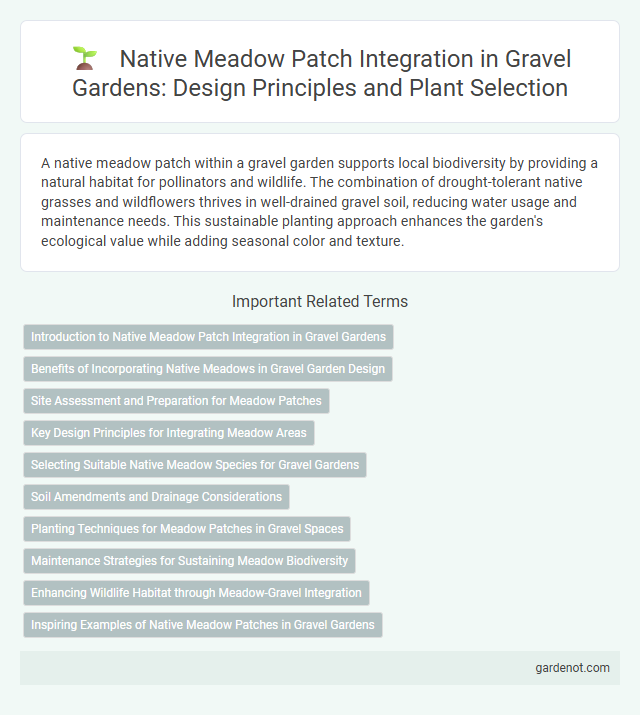A native meadow patch within a gravel garden supports local biodiversity by providing a natural habitat for pollinators and wildlife. The combination of drought-tolerant native grasses and wildflowers thrives in well-drained gravel soil, reducing water usage and maintenance needs. This sustainable planting approach enhances the garden's ecological value while adding seasonal color and texture.
Introduction to Native Meadow Patch Integration in Gravel Gardens
Native meadow patches enhance gravel gardens by introducing drought-tolerant, pollinator-friendly plants such as Echinacea, Rudbeckia, and Little Bluestem. These patches improve soil health and biodiversity, supporting local ecosystems while maintaining the gravel garden's low-maintenance appeal. Integrating native meadows requires selecting species adapted to dry, well-drained conditions and designing layout to complement gravel textures and color palettes.
Benefits of Incorporating Native Meadows in Gravel Garden Design
Incorporating native meadow patches into gravel garden design enhances biodiversity by attracting pollinators such as bees and butterflies, which support local ecosystems. Native meadows improve soil health through deep-rooted plants that stabilize gravel substrates and facilitate water infiltration, reducing erosion. This sustainable landscaping approach also lowers maintenance needs by utilizing plants adapted to local climate conditions, promoting resilience and aesthetic appeal year-round.
Site Assessment and Preparation for Meadow Patches
Conduct a thorough site assessment by analyzing soil type, drainage, sun exposure, and existing vegetation to select suitable native meadow species for the gravel garden. Remove invasive plants and loosen compacted soil to improve root penetration and water absorption. Prepare the site by incorporating organic matter to enhance fertility while ensuring the gravel area maintains proper drainage for healthy meadow patch growth.
Key Design Principles for Integrating Meadow Areas
Incorporating native meadow patches within a gravel garden enhances biodiversity and supports local wildlife by using indigenous plant species adapted to the region's soil and climate conditions. Design principles emphasize selecting drought-tolerant, deep-rooted perennials to improve soil stability, water retention, and reduce maintenance needs. Strategic placement ensures optimal sunlight exposure and natural flow, creating a seamless transition between gravel elements and meadow vegetation that fosters ecological balance.
Selecting Suitable Native Meadow Species for Gravel Gardens
Selecting suitable native meadow species for gravel gardens involves choosing drought-tolerant plants adapted to well-drained, nutrient-poor soils. Species such as Echinacea purpurea, Rudbeckia hirta, and Schizachyrium scoparium thrive in gravel environments while supporting local pollinators. Incorporating a diverse mix of native grasses and wildflowers enhances biodiversity and ensures seasonal interest in gravel garden meadows.
Soil Amendments and Drainage Considerations
Native meadow patches thrive in well-drained soil with organic matter amendments to enhance nutrient retention and moisture balance. Incorporating compost or aged manure improves soil structure and supports beneficial microbial activity, promoting robust root development. Ensuring proper drainage prevents waterlogging, which can harm native plants adapted to drier, gravelly environments.
Planting Techniques for Meadow Patches in Gravel Spaces
Planting techniques for native meadow patches in gravel spaces emphasize soil preparation by incorporating organic matter to improve moisture retention and nutrient availability. Selecting drought-tolerant, deep-rooted native grasses and wildflowers ensures resilience and biodiversity within challenging gravel environments. Proper spacing and mulching reduce weed competition and promote healthy growth, creating a sustainable and visually appealing meadow patch.
Maintenance Strategies for Sustaining Meadow Biodiversity
Native meadow patches in gravel gardens require regular monitoring to manage invasive species that threaten plant diversity. Implementing seasonal mowing and selective grazing helps maintain native flora by preventing woody plant encroachment and promoting seed dispersal. Incorporating organic mulch and minimal irrigation supports soil health and sustains the unique microhabitats essential for meadow biodiversity.
Enhancing Wildlife Habitat through Meadow-Gravel Integration
Native meadow patches integrated within gravel gardens create diverse habitats that support pollinators like bees and butterflies by providing abundant nectar sources and shelter. The combination of deep-rooted meadow plants and porous gravel substrate improves soil health and moisture retention, promoting a sustainable ecosystem. This integration also attracts birds and beneficial insects, enhancing overall biodiversity and ecological resilience in urban and suburban landscapes.
Inspiring Examples of Native Meadow Patches in Gravel Gardens
Native meadow patches in gravel gardens showcase resilient, low-maintenance plantings that thrive in well-drained, nutrient-poor soils while supporting local biodiversity. Examples like the Massachusetts coastal gravel beds use native grasses such as Little Bluestem (Schizachyrium scoparium) alongside wildflowers like Black-eyed Susan (Rudbeckia hirta) to create vibrant, pollinator-friendly habitats. These designs demonstrate how integrating indigenous species enhances ecological balance and aesthetic appeal in minimalist gravel garden settings.
Native meadow patch Infographic

 gardenot.com
gardenot.com